- Joined
- Aug 22, 2011
- Location
- Massachusetts USA
Hey - haven't been back in a while, really since I got my 2500K stable at 44x for several years (damn fine chip!).
Now I've taken the plunge to 6700K + Z170, and I'm glad I waited, as this seems like a goodly jump and the OCing is easier than ever!
But I've got some things that are messing wit me mind:
When I run any stress tests, my package temps keep doing a see-saw pattern, jumping ~20c over the duration (up & down, up & down, ...) Not just jumping up and then plateauing or slowly creeping up from some plateau value - rather jumping up, and then see-sawing. My cooling is a Captain Watercooler 120. I've played with the fan controls for its fan, so that it cranks up the cooling fan sooner... but essentially I see the same pattern (maybe the overall temp is better, but that see-saw effect is plain as day).


As you can see, nearly 20c jump up & down in temps under constant load.
The second oddity is the vcore. According to XTU (pictured above) the vcore is around 1.2290v - this is suspiciously constant, and disagrees with both the MSI Command Center and CPU-Z. During the above test, I had locked it at 1.36v in msicc - and cpu-z agrees - it is currently 1.360 +- .008v.
QUESTIONS:
1. Have any of you experienced these see-saw temp patterns?
2. Any guesses on what's causing it?
3. Does it strike you as a hint that the water cooler isn't functioning properly? Should I be concerned?
4. Is XTU just known to be totally inaccurate for the vcore? Or is that value measuring some other obscure value?
5. What is the current consensus on "24/7 max safe vcore"?
6. If I set the vcore in BIOS or msi CC, I assume it no longer varies with load (as VID does)? (Is that a problem - I liked the old vOffset so that you used VID +/- offest)?
I find it bizarre that Intel's XTU gets the vcore wrong... but I see no other voltage monitoring value in its settings / options that makes better sense (and vcore is shown by default).
I have turned on charting the various throttling values - in case throttling was responsible for the see-saw. However, the chart showed flat-lines on those, so seemed either not to be triggered, or i don't know what to look for.
Thanks for any advice / insight you have to offer. Fun to be OCing again, for a new rig.
Now I've taken the plunge to 6700K + Z170, and I'm glad I waited, as this seems like a goodly jump and the OCing is easier than ever!
But I've got some things that are messing wit me mind:
When I run any stress tests, my package temps keep doing a see-saw pattern, jumping ~20c over the duration (up & down, up & down, ...) Not just jumping up and then plateauing or slowly creeping up from some plateau value - rather jumping up, and then see-sawing. My cooling is a Captain Watercooler 120. I've played with the fan controls for its fan, so that it cranks up the cooling fan sooner... but essentially I see the same pattern (maybe the overall temp is better, but that see-saw effect is plain as day).


As you can see, nearly 20c jump up & down in temps under constant load.
The second oddity is the vcore. According to XTU (pictured above) the vcore is around 1.2290v - this is suspiciously constant, and disagrees with both the MSI Command Center and CPU-Z. During the above test, I had locked it at 1.36v in msicc - and cpu-z agrees - it is currently 1.360 +- .008v.
QUESTIONS:
1. Have any of you experienced these see-saw temp patterns?
2. Any guesses on what's causing it?
3. Does it strike you as a hint that the water cooler isn't functioning properly? Should I be concerned?
4. Is XTU just known to be totally inaccurate for the vcore? Or is that value measuring some other obscure value?
5. What is the current consensus on "24/7 max safe vcore"?
6. If I set the vcore in BIOS or msi CC, I assume it no longer varies with load (as VID does)? (Is that a problem - I liked the old vOffset so that you used VID +/- offest)?
I find it bizarre that Intel's XTU gets the vcore wrong... but I see no other voltage monitoring value in its settings / options that makes better sense (and vcore is shown by default).
I have turned on charting the various throttling values - in case throttling was responsible for the see-saw. However, the chart showed flat-lines on those, so seemed either not to be triggered, or i don't know what to look for.
Thanks for any advice / insight you have to offer. Fun to be OCing again, for a new rig.